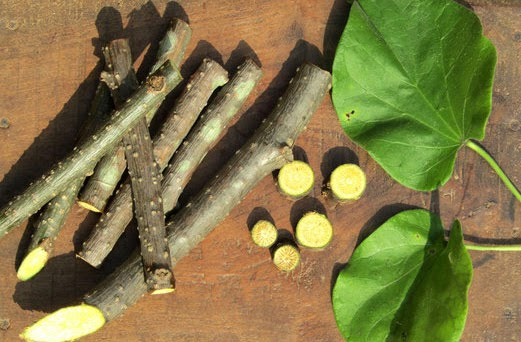description
History
Bhav-Prakash Nighantu provides a mythological description of the origin of Giloy from the drops of divine nectar which were sprinkled on the dead bodies of the Vanars to make them alive who were died during the battle of Rama and Ravan.
As per Ayurveda, Amrita is referred to a creeping plant that endows life by destroying diseasesVernacular names
- English: Gulancha Tinospora, Indian Tinospora, Moon Creeper, Heart Leaved Mood Seed, Bile Killer, Tinospora
- Hindi: Gulancha, Giloy, Amrita, Gulneha, Gulbel, Guloh, Grcha
- Bengali: Golancha, Giloe, Gulancha
- Gujrati: Gulvel, Galo
- Malayalam: Amrutavalli, Chitamruthu, Chitamrith, Amrtu, Amritavalli, Amruth, Siddamirth
- Marathi: Gulvel, Amrita, Amritavalli
- Punjabi: Gilo, Gilo-gulanch, Garham, Palo
- Tamil: Amrutaalli, Chintilikkoti, Chinil, Seendal, Seendil kodi, Silam, Kunali
- Telugu: Tippatige, Dussiramu, Thippateege, Amruta
- Kannada: Amaradaballi, Amrutaballi, Agniballi
- Sanskrit: Jivantika, Vatsahani, Maduparni, Amrtavallari, Chinnaruha, Hinnodabava, Vatsadani, Jivanti, Tantrika, Kunali, Chakralakshinika
- Arabic: Gilo
- Assam: Siddhilata, Amarlata, Shaguni-lata, Geloi, Hoguni-lot
- Kashmiri : Amrita, Gilo
- Oriya: Gulochi, Gulancha
- Urdu: Gurch, Guluncha
- Manipuri: Ningthou Khongli
Classical names
Guduci, Madhuparni, Amrita, Amritavallari, Chhinna, Chhinnaruha, Chinnodbhava, Vatasadani, Tantrika, Kundalini, Chakralakshanika, Somavalli, Dhira, Vishalya, Rasayani, Chandrahasa, Vayastha, Mandala, Devanirmita
Species of Tinospora
There are around 40 species that are distributed in tropical Africa, South-East Asia, Indo Malaya region and Australia. Out of these 40 species only 3 species have been reported from India. According to the Indian medicinal plant, the species of Tinospora which can be used medicinally are as following:
- T. bakis Miers
- T. cordifolia Miers
- T. crispa Miers
- T. malabarika Miers
- T. rumphii Boerl
The Indian species of Tinospora are: Tinospora cordifolia, Tinospora sinesis and Tinospora crispa. Generally, found in tropical and subtropical regions of India.
Morphology
Stem and leaves of Giloy are used for the medicinal purposes. The stem is available in pieces of varying thickness ranging from 0.6 to 5 cm in diameter, young stem is green with a smooth surface and swelling at the nodes. Stem becomes light brown with aging. It has a bitter taste.
Specific characters of different parts:
- Stem: The stem of T. cordifolia is succulent with long filiform, Fleshy aerial roots from the branches with a thick, soft, and watered bark.
- Bark: The colour of the bark is creamy white to grey, large rosette-like lenticels were spotted in the in-between spaces of bark.
- Leaf: The leaves are membranous and cordate at the base. Leaves are alternate on long flexnose petioles. Leaves are 2 to 4 inches long, roundish oval and entire, acute at the apex, quite smooth and thin. The leaves have a bitter taste and an indistinct odour. When seen in bulk leaves look intensely green. When the leaves get matured, they become yellowish.
- Flower: The colour of flowers is yellow or greenish and they are small. The male flowers are present in clustered whereas female flowers are in solitary.
- Fruits: The fruits are short, stalked, sub-globose and drupes. The drupes are ovoid, glossy, succulent, red and pea-sized.
*Flowers grow during the summer and fruits during the winter, fruits are fleshy.


Chemical constituents
Giloy is rich in flavonoids, terpenoids and glycosides. The active chemical constituents of the plant include tinosporine, tinosporic acid, tinosporol, giloin, berbarine, syringin, cordifolioside A, tinosporidine, tinosporoside, tinosporaside etc. The bitter principles of the plant have been identified as chasmanthin, palmarin and columbin. The stem is also rich in proteins, starch, calcium and phosphorus.
- Tinosporine
- Tinosporic acid
- Tinosporol
- Giloin
- Berbarine
- Syringin
- Cordifolioside A
- Tinosporidine
- Tinosporoside
- Tinosporaside





 Whatsapp
Whatsapp